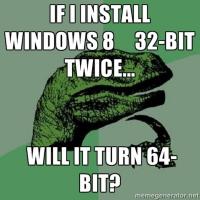32-Bit versus 64-Bit Computing and Why it Matters
By Corporal Punishmenton 07/20/2024 |
 Hey there, Geeks! Have you ever been browsing through the MajorGeeks files database and saw both 32-bit and 64-bit versions of the same program listed? Wondered about the difference between 32-bit and 64-bit computing / and software? You've come to the right place. Let's dive into the fascinating world of bits and bytes and clear this up for you.
Hey there, Geeks! Have you ever been browsing through the MajorGeeks files database and saw both 32-bit and 64-bit versions of the same program listed? Wondered about the difference between 32-bit and 64-bit computing / and software? You've come to the right place. Let's dive into the fascinating world of bits and bytes and clear this up for you.A Bit of History (Pun intenended : ) )
64-bit computing kicked off with the monstrous Cray-1 supercomputer in 1975, tailored for intense scientific tasks, followed by the DEC Alpha in 1992, which brought 64-bit power into the commercial realm. Microsoft didn't enter the 64-bit ring until 2005 with Windows XP Professional x64 Edition. As multitasking and high-demand applications became commonplace, the shift to 64-bit became inevitable. By the time Windows 7 launched in 2009, and especially with Windows 10 and 11, 64-bit systems had become the standard, essential for anyone looking to maximize their computer's capabilities for everything from advanced gaming to complex data processing.
What's the Big Deal with 32-Bit and 64-Bit?
In computing, The smallest data unit is a "bit" (short for binary digit). It can hold one of two values: 0 or 1. 32-bit and 64-bit actually refer to the data width your CPU can handle. So, 32-bits send 32 0's or 1's in a single chunk and 64 Bit architecture sends 64 0's or 1's simultaneously. Think of it as a highway. A 32-bit system is like a highway with two lanes, allowing a certain number of cars suitable for less demanding travel but prone to congestion with volumes. In contrast, a 64-bit system doubles the lanes, significantly increasing traffic capacity and speed. A 64-bit processor can munch through data faster than a 32-bit processor because it can handle more data at once.
Memory Limitations: One of the most significant differences between 32-bit and 64-bit processors is how much RAM they can use. A 32-bit system is capped at accessing about 4GB of RAM. In contrast, a 64-bit system can theoretically handle up to a whopping 16 exabytes. That is a billion gigabytes or 15,625,000 64GB modules. That will cost you a smidge less than 1 billion on Amazon with a 2-pack. So you have a little room for expansion. (Though most operating systems will cap this much lower, like 128GB). This is why most modern PCs have moved to 64-bit architectures.
Performance Perks: When it comes to performance, 64-bit systems are always the winners, especially if you're into things like gaming, video editing, or any other resource-heavy tasks. These systems can handle more calculations per second, manage larger files, and perform more complex processes than their 32-bit counterparts. By far. Despite the dominance of 64-bit systems, there are practical reasons to use a 32-bit system. Some older or specialized software only runs on 32-bit systems, making them essential for legacy software compatibility. Required hardware that may not support 64-bit operating systems or drivers. Additionally, 32-bit systems have lower resource requirements, making them more efficient on devices with less than 4GB of RAM and more cost-effective for certain low-power devices. So, to this day, many developers need to make sure their applications work on both 32-bit and 64-bit systems. These factors keep 32-bit systems relevant.
Can You Mix and Match?
The short answer: nope. A 32-bit system can't handle the demands of 64-bit software—it's like trying to fit a golf ball through a garden hose. However, if you have a 64-bit system, you can usually run 32-bit software just fine. Sometimes, there is an issue; however, thanks to the magic of compatibility mode, newer systems play nice with older games.
Who Should Use What?
Go for 32-bit if:
- You have older hardware that isn't compatible with 64-bit software.
- You're running applications that are only available in 32-bit.
- You're that guy still on XP and refuses to upgrade.
Opt for 64-bit if:
- You’re using your PC for high-performance tasks like modern gaming, multimedia editing, or heavy multitasking.
- You want to future-proof your system as much as possible.
- Security and software compatibility are your priorities.
How to Tell What You've Got
Wondering how to check if your system is 32-bit or 64-bit? It's pretty easy:
- Windows users: Just head to 'System' in your Control Panel, and look for 'System type' under System Information. It’ll tell you whether your OS and processor are 32-bit or 64-bit.
- Mac users: Click on the Apple icon and go to 'About This Mac.' All modern Macs are 64-bit, but this will confirm your system details.
Wrapping Up
Understanding the differences between 32-bit and 64-bit in computers helps you make more informed decisions but sometimes, bigger really is better, especially when it comes to bits! If you have any questions or need further clarification, just shout (or type) in the comments below.
comments powered by Disqus






